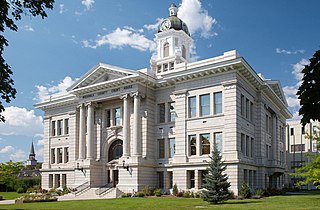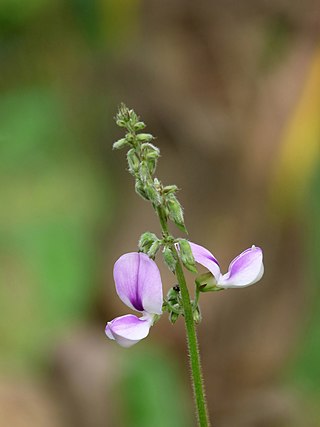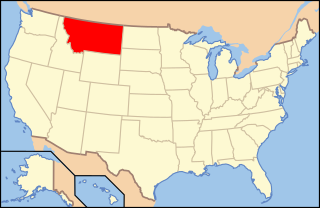
Kudzu, also called Japanese arrowroot or Chinese arrowroot, is a group of climbing, coiling, and trailing deciduous perennial vines native to much of East Asia, Southeast Asia, and some Pacific islands, but invasive in many parts of the world, primarily North America.

Missoula County is located in the State of Montana. As of the 2020 census, the population was 117,922, making it Montana's third-most populous county. Its county seat and largest city is Missoula. The county was founded in 1860.

Arnica is a genus of perennial, herbaceous plants in the sunflower family (Asteraceae). The genus name Arnica may be derived from the Greek arni, "lamb", in reference to the plants' soft, hairy leaves. Arnica is also known by the names mountain tobacco and confusingly, leopard's bane and wolfsbane—two names that it shares with the entirely unrelated genus Aconitum.

Arnica montana, also known as wolf's bane, leopard's bane, mountain tobacco and mountain arnica, is a moderately toxic European flowering plant in the daisy family Asteraceae that has a large yellow flower head. The names "wolf's bane" and "leopard's bane" are also used for another plant, aconitum, which is extremely poisonous.

Pueraria is a genus of 15–20 species of legumes native to south, east, and southeast Asia and to New Guinea and northern Australia. The best known member is kudzu, also called Japanese arrowroot. The genus is named after 19th century Swiss botanist Marc Nicolas Puerari.

The Hell Creek Formation is an intensively studied division of mostly Upper Cretaceous and some lower Paleocene rocks in North America, named for exposures studied along Hell Creek, near Jordan, Montana. The formation stretches over portions of Montana, North Dakota, South Dakota, and Wyoming. In Montana, the Hell Creek Formation overlies the Fox Hills Formation. The site of Pompeys Pillar National Monument is a small isolated section of the Hell Creek Formation. In 1966, the Hell Creek Fossil Area was designated as a National Natural Landmark by the National Park Service.

The hybrid elm cultivar Ulmus × hollandica 'Dampieri', one of a number of cultivars arising from the crossing of the Wych Elm U. glabra with a variety of Field Elm U. minor, is believed to have originated in continental Europe. It was marketed in Wetteren, Belgium, in 1851 as 'Orme de Dampier', then in the Low Countries in 1853, and later identified as Ulmus campestris var. nuda subvar. fastigiata DampieriHort., Vilv. by Wesmael (1862).
The elm cultivar Ulmus 'Atropurpurea' [:dark purple] was raised from seed at the Späth nursery in Berlin, Germany, circa 1881, as Ulmus montana atropurpurea, and was marketed there till the 1930s, being later classed as a cultivar by Boom. Henry (1913) included it under Ulmus montana cultivars but noted that it was "very similar to and perhaps identical with" Ulmus purpureaHort. At Kew it was renamed U. glabraHuds. 'Atropurpurea', but Späth used U. montana both for wych elm and for some U. × hollandica hybrids, so his name does not necessarily imply a wych elm cultivar. The Hesse Nursery of Weener, Germany, however, which marketed 'Atropurpurea' in the 1950s, listed it in later years as a form of U. glabraHuds..

The Wych Elm cultivar Ulmus glabra 'Cornuta', in cultivation before 1845 – Fontaine (1968) gives its provenance as France, 1835 – is a little-known tree, finally identified as a cultivar of U. glabra by Boom in Nederlandse Dendrologie 1: 157, 1959.

The hybrid elm cultivar Ulmus × hollandica 'Superba' is one of a number of intermediate forms arising from the crossing of the Wych Elm U. glabra with a variety of Field Elm U. minor. Boulger tentatively (1881) and Green more confidently (1964) equated it with a hybrid elm cultivated in the UK by Masters at Canterbury in the early 19th century, known as "Masters' Canterbury Seedling" or simply the Canterbury Elm. Loudon examined a specimen sent by Masters and considered it a hybrid, calling it U. montana glabra major.
The hybrid elm cultivar Ulmus × hollandica 'Tricolor' was first listed as U. suberosa tricolor by C. de Vos in 1867.

Athamanta turbith is a species of flowering plant in the family Apiaceae. It is endemic to southern Europe and northern Africa.

Eastern Montana is a loosely defined region of Montana. Some definitions are more or less inclusive than others, ranging from the most inclusive, which would include the entire part of the state east of the Continental Divide, to the least inclusive, which places the beginning of "eastern" Montana roughly at or even east of Billings, Montana. The areas of Montana lying just east of the Continental Divide are often called Central Montana. A widely accepted definition of Eastern Montana is that it encompasses the eastern third of the state.

Epermenia aequidentellus, also known as the carrot lance-wing, is a moth of the family Epermeniidae found in Europe, Madeira and the Canary Islands. It was first described by Ernest Hofmann in 1867, from a specimen found in Vorderer Kaiser, near Kufstein, Austria.

Paleontology in Montana refers to paleontological research occurring within or conducted by people from the U.S. state of Montana. The fossil record in Montana stretches all the way back to the Precambrian. During the Late Precambrian, western Montana was covered by a warm, shallow sea where local bacteria formed stromatolites and bottom-dwelling marine life left tracks on the sediment that would later fossilize. This sea remained in place during the early Paleozoic, although withdrew during the Silurian and Early Devonian, leaving a gap in the local rock record until its return. This sea was home to creatures including brachiopods, conodonts, crinoids, fish, and trilobites. During the Carboniferous the state was home to an unusual cartilaginous fish fauna. Later in the Paleozoic the sea began to withdraw, but with a brief return during the Permian.
Wayfarers State Park is a 67-acre (27 ha) public recreation area overlooking Flathead Lake, one-half mile south of Bigfork, Montana. The state park hosts the annual Northern Rockies Paddlefest, which in 2013 attracted over 200 participants.

The elm cultivar Ulmus 'Fastigiata Glabra' was distributed by the Späth nursery, Berlin, in the 1890s and early 1900s as U. montana fastigiata glabra. Späth used U. montana both for cultivars of wych elm and for those of some U. × hollandica hybrids like 'Dampieri'. A specimen of U. montana fastigiata glabra in the Royal Botanic Garden Edinburgh was determined by Melville in 1958 as a hybrid of the U. × hollandica group.
The Wych Elm cultivar Ulmus glabra 'Gigantea' was listed as U. montana var. giganteaHort. by Kirchner (1864). An U. montana gigantea was distributed by the Späth nursery, Berlin, in the 1890s and early 1900s. It did not appear in Späth's 1903 catalogue. A specimen at Kew was judged by Henry to be "not distinct enough to deserve a special name". Both Späth and the Hesse Nursery of Weener, Germany, supplied it in the 1930s.

The wych elm cultivar Ulmus glabra 'Nitida' [:'shining', an allusion to the smooth upper surface of the leaves], the smooth glossy-leaved wych, was described by Fries from specimens collected by P. C. Afzelius in 1841 on the island of Stora Karlsö, Sweden, as Ulmus montana nitida, in Novitiae Florae Suecicae: continuatio, sistens Mantissam III: 20 (1842). The Novitiae Florae Gotlandicae (1844) confirmed U. montana f. nitidaFr. as present on the islands of Stora Karlsö and neighbouring Lilla Karlsö off Gotland, Sweden, but did not report it from Gotland proper. A Stora Karlsö specimen from the Herbarium E. Fries is preserved in the Botanical Museum of Uppsala. The tree was listed by Rehder as U. glabraHuds. f. nitida (1915), a designation adopted by Krüssmann (1984), the latter copying Rehder's 'Norway' provenance error.













